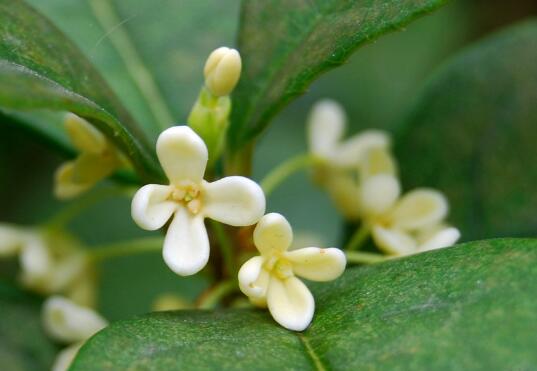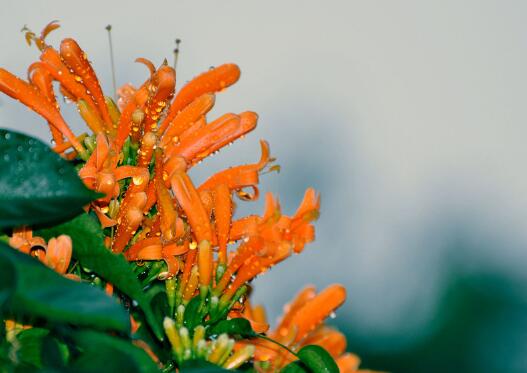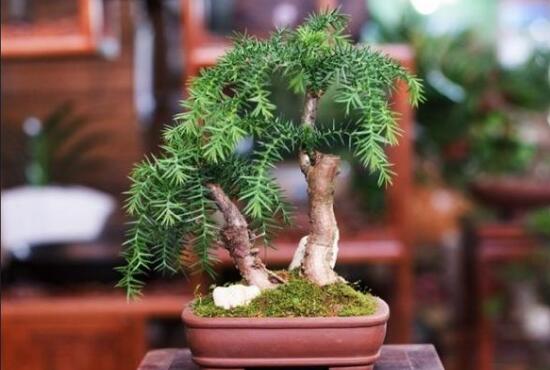The difference between Cinnamomum chinense and Cinnamomum chinense is different in body shape / shape / breeding method.
Japanese cinnamon and four seasons cinnamon are two different plants, four seasons cinnamon belongs to metaphora, while Japanese incense belongs to transition flower order, but because of their similar appearance, they are often confused by people. In fact, there are many differences between the two. What are the differences between Japanese cinnamon and four seasons cinnamon? Next, the editor will take you to learn about it.
Japanese cinnamon, cinnamon and cinnamon

In fact, there is no standard answer to the question of which is better for Japanese cinnamon and cinnamon in the four seasons, because everyone's preferences are different, so it is impossible to say which is better. The advantages of Japanese cinnamon and four seasons cinnamon are long viewing period and long flowering period, while cinnamon is rich in fragrance, so which one is better depends on your personal preference.
Second, the difference between Japanese cinnamon and four seasons cinnamon
Cinnamomum cinnamon
Osmanthus fragrans is a horticultural variety of sweet-scented osmanthus. Each new shoot of Osmanthus fragrans has 3 pairs of leaves, and each leaf axil has 2 pairs of overlapping axillary buds. Other varieties of Osmanthus fragrans generally have only 2 pairs of leaves per shoot, and only 1 pair of solitary or superimposed leaf buds in the axils of each leaf. This results in its objective material basis of more flowering quantity and greater flowering potential, with a cumulative annual flowering period of more than 200 days, and the variety is therefore named Japanese cinnamon.
Sijigui
Four seasons osmanthus is a variety of sweet clover sweet-scented osmanthus, its leaves are opposite, mostly oval or long oval, the leaf surface is smooth, leathery, the leaf edge is serrated; autumn flowering, flower clusters born in leaf axils, Corolla split to basal milk, milky white, yellow, orange-red and other colors, extremely fragrant; drupe is purple-black after maturity, this plant is mainly distributed in Zhejiang, Jiangsu, Fujian, Taiwan, Sichuan and Yunnan in China.
1. Somatotype difference
When it comes to the difference between Japanese osmanthus and four seasons osmanthus, the most obvious is their volume, although both are one of the varieties of sweet-scented osmanthus, but there is still a great difference in volume. The plant height of cinnamon is generally about 6 meters, and the color of bark is generally light gray, while the plant height of four seasons cinnamon is up to 12 meters, and the color of bark is relatively dark, generally dark brown.
two。 Appearance difference
In addition to their body shape, we can also see their differences in appearance. First of all, in terms of leaves, the leaves of cinnamon are generally green or dark green, and the surface will be shiny, while the leaves of cinnamon generally grow symmetrically. Relatively speaking, the leaves are also relatively thin and suspicious. Secondly, in the flower color, the flowers of cinnamon are mostly light yellow or lemon yellow, while the flowers of four seasons cinnamon are white or light yellow.
3. Reproductive distinction
In addition to the above two points, we can also see the difference between Cinnamomum chinense and Cinnamomum chinense from the propagation methods. The propagation method of Cinnamomum cassia is generally based on cutting propagation, while grafting propagation can also be carried out. On the other hand, the propagation methods of four seasons cassia are relatively more, which can not only be cut and grafted, but also be used for strip propagation, and the survival rate is also very high.
The difference between Japanese cinnamon and four seasons cinnamon
Sweet-scented osmanthus tree is a very beautiful plant and flower, and contains many varieties, such as cinnamon, silver cinnamon, eight laurel and four seasons osmanthus, etc., which is not a common evergreen broad-leaved tree in our daily life. This kind of flowers are generally in full bloom in golden autumn and full of small yellow and white flowers, competing with each other, extremely beautiful, and sweet-scented osmanthus trees with rich fragrance It is loved by many friends. But there are still a lot of people can not go to the different sweet-scented osmanthus, below, YJBYS editor for you to collect and sort out, the difference between cinnamon and four seasons osmanthus, let's have a look!
The difference between Japanese cinnamon and four seasons cinnamon
Japanese cinnamon is a variety of four seasons cinnamon, the plant of Japanese cinnamon is relatively loose, and the distance between nodes is relatively long, while the plant of four seasons cinnamon is more dense and shorter. The leaves of Cinnamomum chinense are like willow leaves, and the older leaves are serrated, and the edges of the leaves are rolled downwards. It is easy to tell the difference between cinnamon and cinnamon by hand touch.
The color of cinnamon flowers is more yellowing, and the flowers are also relatively small, growing less, but can continue to bloom, flowering is also more mature. The flowers of four Seasons Cinnamomum are more colorful than the price, there are white, red, yellow, the fragrance of the flowers is relatively rich, very popular with people. Ordinary people like to cultivate cinnamon very much, which has a very good ornamental value.
Cinnamon incense
Cinnamon, also known as Jiuli incense and wood rhinoceros, belongs to an evergreen shrub plant. It has more branches, and the nodes of the plant are relatively short. The glossiness of the leaves is very good and the color is green. There are a few teeth on the leaf edge of the leaf. It has petioles, glandular spots on both sides, bisexual flowers, inflorescences clustered above the axils of leaves, bracts with two bracts, and the base is connate, and the calyx is clock-shaped.
The Corolla is white or yellow-white, cylindrical or jar-shaped, and has fruit growth. When the flowers are in full bloom, they will give out a pleasant fragrance, giving people a refreshing feeling. It can blossom all the year round, and the flowering period is continuous. The forest of the plant is generally 100 years old, and the height of the tree is 6m, while the height of DBH is 22cm, and the crown width is 5.8m. It is generally distributed in Fujian, Guangdong, Hainan, Guangxi, Northeast, North China and so on.
Sijigui
Four seasons laurel, also known as laurel, is a tree plant belonging to the genus Oleaceae. Its leaves are opposite in shape, generally long oval and oval in shape, with smooth leaves and thin, leathery leaves. The edges of the leaves are jagged. The four seasons cinnamon usually blooms in autumn, and the flowers grow under the leaf axils, the Corolla is divided into basal milk, the color of the flowers is very rich, such as white, yellow, orange and so on, the aroma is overflowing, and the drupe is purple-black after maturity.
Four seasons osmanthus is a variation of sweet-scented osmanthus in the genus Osmanthus. The biggest difference between it and its sweet-scented osmanthus tree is that it will blossom all the year round, once called four seasons osmanthus and laurel. But its flower smell is one of the weakest sweet-scented osmanthus trees, it is generally difficult to smell the smell of flowers, the varieties of four seasons osmanthus are divided into Japanese cinnamon, four seasons cinnamon, laurel, Tianxiangtai GE Gui and so on.
Culture methods of four Seasons Cinnamomum
First, water conditions. The four seasons sweet-scented osmanthus needs to be watered appropriately, and the principle of "two less than one" should be mastered. Plants that change pots before the occurrence of new shoots of sweet-scented osmanthus need less watering. At the same time, cloudy and rainy weather also needs less watering. Dry and early weather such as summer and autumn should be watered more. After watering through the basin, it is often necessary to maintain about 50% water content, and the soil water content should be about 60% after incubation from July to September. Generally, the basin soil can be pinched into a ball and put down, that is, it is enough to disperse water. At the same time, attention should be paid to drainage on cloudy and rainy days to prevent stagnant water from rotting roots and drowning.
Second, soil conditions. Osmanthus fragrans like to grow in slightly acidic, well drained and fertile sandy loam. On the contrary, Osmanthus fragrans grows slowly in strongly acidic soil with few withered branches of yellow leaves, showing a phenomenon of malnutrition. We generally grafted two-year-old seedlings in the soil with a pH value of 3-4. The branches of the year are generally 2-3, and the branch length is about 6cm, which is 2 times less than that in the soil with pH 6. The leaf withered ginger appeared and died gradually after two or three months in alkaline soil.
Third, the conditions of fertilization. People all say that the flourishing flower lies in fertilizer, and the sweet-scented osmanthus of the four seasons is more like and suitable to use pig manure as fertilizer, we can mix it in the pot soil or rot and dry it and put it at the bottom of the pot, the amount of fertilizer is generally based on the pot height of 1cm 4 and the fertilizer needs to cover a layer of soil about 1 inch 2 inches thick, and then plant the four seasons osmanthus, you can no longer apply fertilizer within a year. If raised in urban areas, the horns of donkeys, horses or mules can be poked into water and watered once in the spring and every 7-10 days before August.
Fourth, modeling conditions. The four seasons sweet-scented osmanthus is a kind of strong ornamental plant, mainly to watch leaves, types and flowers. Although this kind of sweet-scented osmanthus flowers are small but fragrant, the leaves and types are very beautiful, so we need to show prosperity and wealth when we shape the sweet-scented osmanthus. Solemn and elegant and innocent spirit, to achieve beauty, we can choose privet as rootstock, and first move the big-leaf privet to the flowerpot. During the period from the Summer Solstice to the Autumn Equinox, the grafting method can be used. After survival, the sweet-scented osmanthus is cut off from the mother to form a new sweet-scented osmanthus, which is generally able to survive.
The difference between Japanese cinnamon and four seasons cinnamon
.html
What is the difference between Japanese cinnamon and four seasons cinnamon?
There are many kinds of sweet-scented osmanthus, and the common sweet-scented osmanthus trees have four seasons osmanthus, eight laurel, golden osmanthus, silver osmanthus and so on. They are all plants with very good ornamental value. People often raise them in gardens, parks, courtyards and indoors. They can give off a faint fragrance of flowers and bring people a feeling of being close to nature, which is very comfortable. How different are the species of each kind of sweet-scented osmanthus, and so are Japanese cinnamon and four seasons osmanthus. Let's take a look at the difference between Japanese incense and four seasons osmanthus.
The difference between Japanese cinnamon and four seasons cinnamon
Cinnamon, also known as Jiuli incense and wood rhinoceros, belongs to an evergreen shrub plant. It has more branches, and the nodes of the plant are relatively short. The glossiness of the leaves is very good and the color is green. There are a few teeth on the leaf edge of the leaf. It has petioles, glandular spots on both sides, bisexual flowers, inflorescences clustered above the axils of leaves, bracts with two bracts, and the base is connate, and the calyx is clock-shaped. The Corolla is white or yellow-white, cylindrical or jar-shaped, and has fruit growth. When the flowers are in full bloom, they will give out a pleasant fragrance, giving people a refreshing feeling. It can blossom all the year round, and the flowering period is continuous. The forest of the plant is generally 100 years old, and the height of the tree is 6m, while the height of DBH is 22cm, and the crown width is 5.8m. It is generally distributed in Fujian, Guangdong, Hainan, Guangxi, Northeast, North China and so on.
The difference between Japanese cinnamon and four seasons cinnamon
Four seasons laurel, also known as laurel, is a tree plant belonging to the genus Oleaceae. Its leaves are opposite in shape, generally long oval and oval in shape, with smooth leaves and thin, leathery leaves. The edges of the leaves are jagged. The four seasons cinnamon usually blooms in autumn, and the flowers grow under the leaf axils, the Corolla is divided into basal milk, the color of the flowers is very rich, such as white, yellow, orange and so on, the aroma is overflowing, and the drupe is purple-black after maturity. Four seasons osmanthus is a variation of sweet-scented osmanthus in the genus Osmanthus. The biggest difference between it and its sweet-scented osmanthus tree is that it will blossom all the year round, once called four seasons osmanthus and laurel. But its flower smell is one of the weakest sweet-scented osmanthus trees, it is generally difficult to smell the smell of flowers, the varieties of four seasons osmanthus are divided into Japanese cinnamon, four seasons cinnamon, laurel, Tianxiangtai GE Gui and so on.
The difference between Japanese cinnamon and four seasons cinnamon
Japanese cinnamon is a variety of four seasons cinnamon, the plant of Japanese cinnamon is relatively loose, and the distance between nodes is relatively long, while the plant of four seasons cinnamon is more dense and shorter. The leaves of Cinnamomum chinense are like willow leaves, and the older leaves are serrated, and the edges of the leaves are rolled downwards. It is easy to tell the difference between cinnamon and cinnamon by hand touch. The color of cinnamon flowers is more yellowing, and the flowers are also relatively small, growing less, but can continue to bloom, flowering is also more mature. The flowers of four Seasons Cinnamomum are more colorful than the price, there are white, red, yellow, the fragrance of the flowers is relatively rich, very popular with people. Ordinary people like to cultivate cinnamon very much, which has a very good ornamental value.
The value of Japanese cinnamon and four seasons cinnamon
1. Japanese osmanthus: it is a very rare plant belonging to sweet-scented osmanthus, which is evergreen all the year round, has good resistance, and is very easy to breed. It blossoms for a total of 240 days in a year, and the more exuberant flowering time is from September to April. It is a landscaping plant and is often used as a bonsai plant. It can extract aromatic oils from natural plants and has health effects such as reducing phlegm, lowering blood pressure, relieving cough and asthma, anti-inflammation and antibacterial, and has very good ornamental value.
two。 Four seasons cinnamon: the leaves and fruits of four seasons cinnamon can extract very good aromatic oils, it can be made into a variety of food and soap flavors, and leaves can be used as fragrance and canned spices. Four Seasons Osmanthus is a very good variety of sweet-scented osmanthus, which can open an account all the year round, and has the function of beautifying the environment. Can be stewed meat, mainly for toothache, sore throat. Four seasons cinnamon has a very good resistance to sulfur dioxide and hydrogen fluoride. In order to purify the air, it is suitable to be planted in gardens and some public places. It is a very popular plant.
What is the difference between Japanese cinnamon and four seasons cinnamon is shared here with you. I hope this article will be helpful to the crackdown. Good luck.
- Prev

Does firecracker flower grow insects? pest control of firecracker flower / 2 insect pests 2 diseases
In the process of firecracker flower growth, what people are most afraid of is the problems of diseases and insect pests, which do great harm to the plant, not only affect the ornamental, but also cause the plant wilt if not dealt with in time. About firecrackers, flowers and worms? How to control the diseases and insect pests of firecrackers
- Next

Which is more expensive, Australian fir or yew? the price of Australian fir bonsai ranges from 400 to 1200 yuan.
Raising plants indoors has become a popular trend, for which many flower lovers love bonsai, and as the best in bonsai, Australian fir and yew are naturally loved by more people. If you want to keep it, you have to know the price. What about the price of Australian fir bonsai and yew bonsai? Which is more expensive, Australian fir or yew?
Related
- Fuxing push coffee new agricultural production and marketing class: lack of small-scale processing plants
- Jujube rice field leisure farm deep ploughing Yilan for five years to create a space for organic food and play
- Nongyu Farm-A trial of organic papaya for brave women with advanced technology
- Four points for attention in the prevention and control of diseases and insect pests of edible fungi
- How to add nutrient solution to Edible Fungi
- Is there any good way to control edible fungus mites?
- Open Inoculation Technology of Edible Fungi
- Is there any clever way to use fertilizer for edible fungus in winter?
- What agents are used to kill the pathogens of edible fungi in the mushroom shed?
- Rapid drying of Edible Fungi

